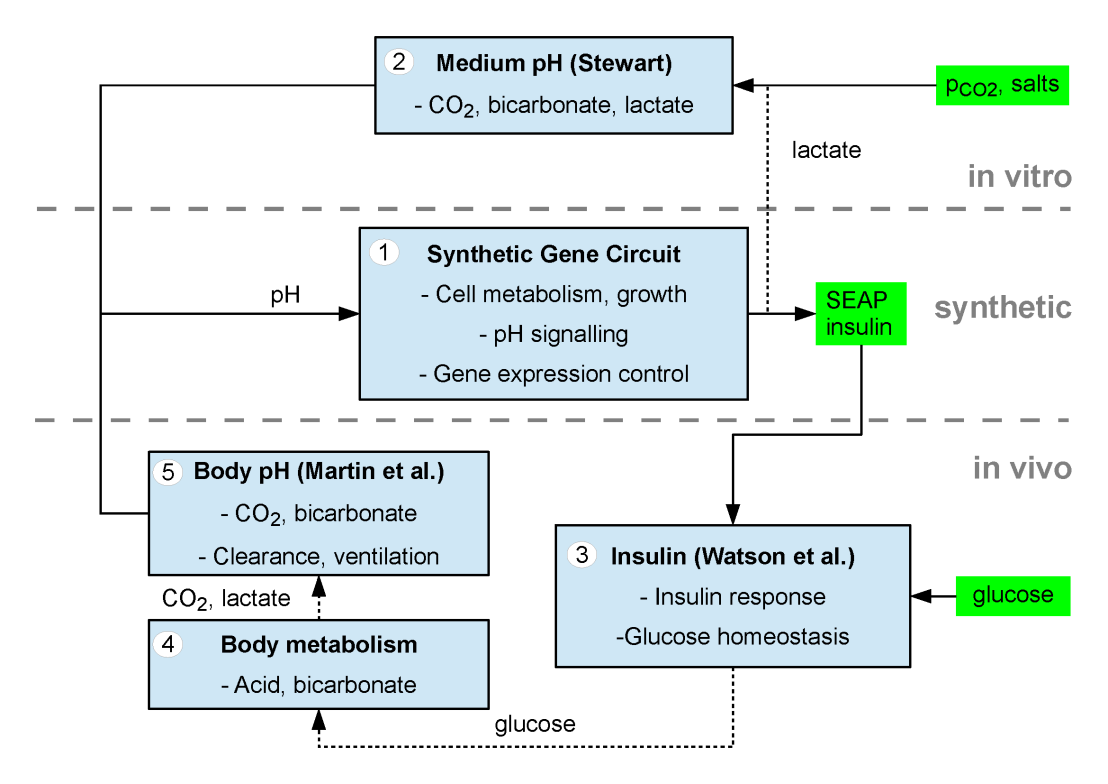Synthetic Biology
Synthetic biology aims at the design and implementation of novel functions into biological cells and organisms. It attempts to transfer approaches that are common in ‘established’ engineering disciplines, such as computer-aided design and manufacturing, to biological engineering. However, limited insulation and ‘sloppiness’ of biological parts as well as stochastic noise contribute new challenges in biological systems design. We explore model-based methods for the rational design of synthetic systems, with applications both in yeast biology and in mammalian systems engineering (where biomedical applications are in the focus). For an efficient manufacturing of synthetic circuits, we emphasize laboratory automation.
Computer-Aided Design

An appealing idea for synthetic gene circuit design is to use biological parts that can be combined in a modular fashion to construct circuits with novel functionalities. In contrast to other engineering disciplines, these parts interact with each other and with the cellular environment in often complex ways. To enable rational circuit design that takes these interactions into account, we focused on developing mathematical models for parts and their interactions that enable computer-aided circuit design in a plug-and-play manner. Example applications include the automatic design of digital gene circuits that respond to multiple inputs following a pre-programmed logic. Further developments of these approaches are part of our participation in the external page NCCR Molecular Systems Engineering.
Marchisio MA, Colaiacovo M, Whitehead E, Stelling J (2013) Modular, rule-based modeling for the design of eukaryotic synthetic gene circuits. BMC Syst Biol 7: 42. external page http://doi.org/10.1186/1752-0509-7-42.
Marchisio MA, Stelling J (2011) Automatic design of digital synthetic gene circuits. PLoS Comput Biol 7: e1001083. external page http://doi.org/10.1371/journal.pcbi.1001083.
Marchisio MA, Stelling J (2009) Computational design tools for synthetic biology. Curr Opin Biotechnol 20: 479-485. external page http://doi.org/10.1016/j.copbio.2009.08.007.
Marchisio MA, Stelling J (2008) Computational design of synthetic gene circuits with composable parts. Bioinformatics 24: 1903-1910. external page http://doi.org/10.1093/bioinformatics/btn330.
Mammalian Synthetic Biology

The development of gene circuits in mammalian cells that sense and respond to physiological signal presents a novel approach to biomedical applications, for example, in designer-cell based therapies. In our long-term collaboration with the Fussenegger group (D-BSSE), we contribute with the development and analysis of mathematical models to the design and optimization of implantable, so-called ‘prosthetic networks’. Central questions concern, for example, multiscale modeling to bridge the gap between in vitro and in vivo behaviors of designed circuits. Example applications include synthetic controllers for insulin regulation in type I diabetes and for uric acid regulation in gouty arthritis.
Auslander D, Auslander S, Charpin-El Hamri G, Sedlmayer F, Muller M, et al. (2014) A synthetic multifunctional mammalian pH sensor and CO2 transgene-control device. Mol Cell 55: 397-408. external page http://doi.org/10.1016/j.molcel.2014.06.007.
Bacchus W, Lang M, El-Baba MD, Weber W, Stelling J, et al. (2012) Synthetic two-way communication between mammalian cells. Nat Biotechnol 30: 991-996. external page http://doi.org/10.1038/nbt.2351.
Kemmer C, Gitzinger M, Daoud-El Baba M, Djonov V, Stelling J, et al. (2010) Self-sufficient control of urate homeostasis in mice by a synthetic circuit. Nat Biotechnol 28: 355-360. external page http://doi.org/10.1038/nbt.1617.
Tigges M, Marquez-Lago TT, Stelling J, Fussenegger M (2009) A tunable synthetic mammalian oscillator. Nature 457: 309-312. external page http://doi.org/10.1038/nature07616.
Laboratory Automation

Implementing synthetic gene circuits, especially at larger scale, is still challenging and it requires substantial manual efforts. Laboratory automation with liquid-handling robots could alleviate this problem, but translating experimental protocols to robots is not straight-forward. To address this issue, we collaborate with the external page Shapiro group (Weizmann Institute) in developing an open-source, portable, and high-level programming language for liquid handling robots; it is tested with D-BSSE’s laboratory automation facility, also to speed up our applications in yeast synthetic biology (apart from less serious demonstrations as shown in the image). Ongoing research also addresses how protocols for gene circuit construction could be optimized using mathematical models, for example, for conducting polymerase chain reactions (PCRs).
To come soon.